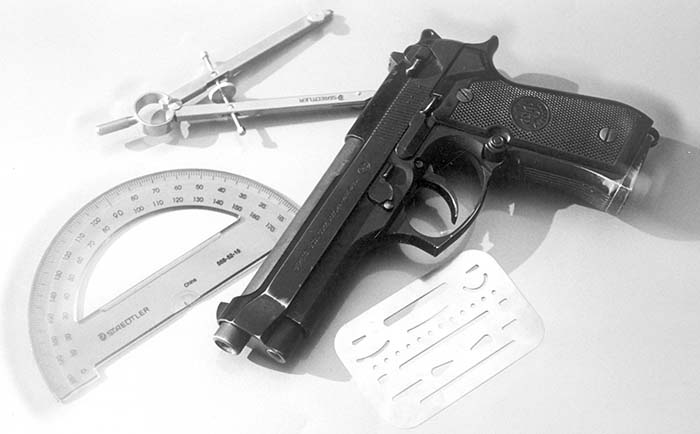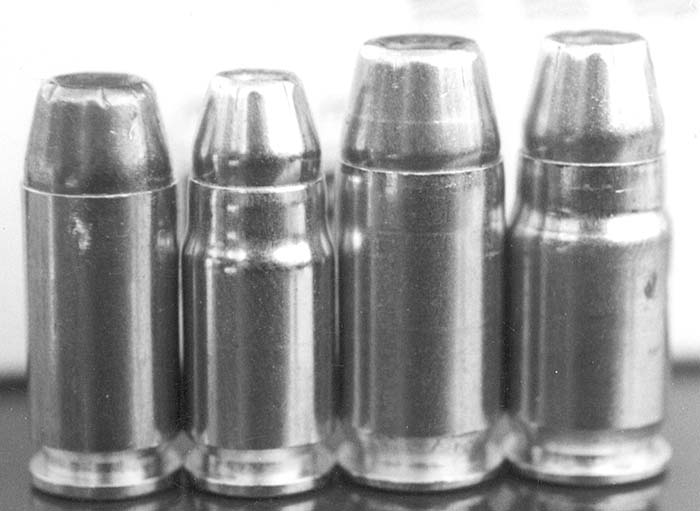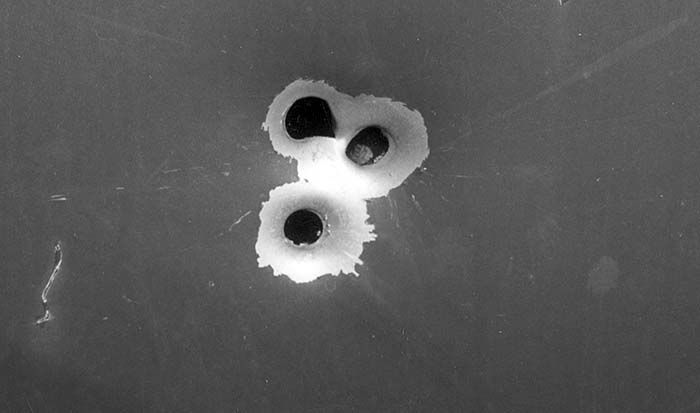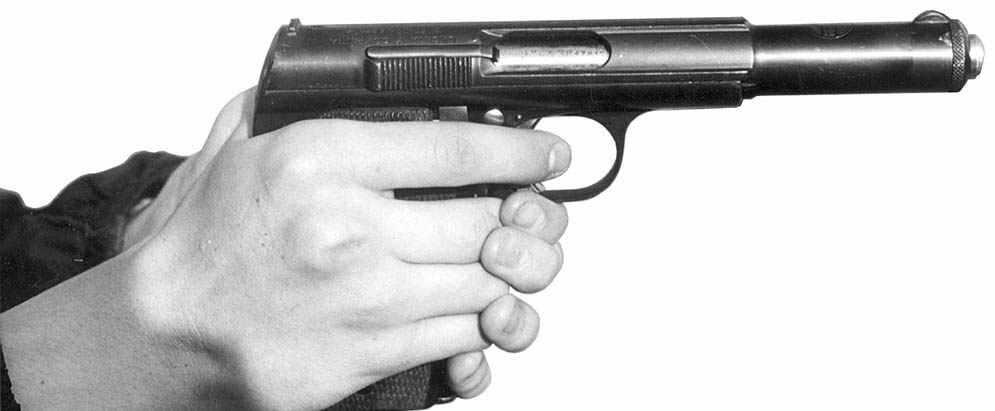The angular and unattractive Astra 9mm Largo is a very accurate reliable and well-made handgun.
By Bob Campbell
It is easy to make a case for the 9x19mm Parabellum cartridge as the most popular handgun caliber of all time, and even easier to make a case for the 9mm as the most popular bullet diameter for semi auto handguns. The various 9mms are not well understood and seldom interchangeable, and each has a bit of history behind them.
First, I examined the cartridge case list offered by our premier brass maker, Starline. There were no less than eleven 9mm calibers, all of which can use the same bullet. These included the .380 ACP, 9 Super Comp (9x 23mm), 9x19mm Parabellum, 9mm +P, 9 x 21mm, 9x18mm Makarov, 9mm Largo, 9mm Win. Mag, .38 Super, .38 Super +P and .38 Super Comp. By contrast there are six .38 caliber revolver cases and three .45 auto cases. (The .45 ACP, .45 +P and .45 Super.)

In the 9mm family we find true rimless cartridges like the 9x19mm Parabellum but also the semi-rimmed .38 ACP and .38 Super. I stated all could use the same bullets. The 9 x 18 Makarov actually uses a .363-inch bullet while the others use .355 inch jacketed or .356 to .358 inch lead bullets, but the Makarov performs adequately with jacketed 9mm bullets. Some .38 Supers do well with .357-inch revolver bullets. I have extensive experience with quite a few, especially the Largo, Parabellum and .38 Super variants. I am experimenting with the newest and arguably the best, from Hornady. Careful attention to each caliber is demanded – not many will be able to quote dimensions and loading data off the top of their head.
9mm Luger
The first pistol cartridges were bottleneck types for easy feeding in then new semiauto pistols. But .30 caliber FMJ (Full Metal Jacket) bullets proved relatively ineffective in use. The powerful .30 Mauser was said to be effective if it hit bone. Adventurer Winston Churchill found it quite deadly. The .30 Luger was less powerful. When blown out to 9mm it offered more acceptable wound potential. This is quite the opposite of the modern fashion of necking cases down, but precedent can be found in the rebated cylinder of the 1860 Colt Army .44 revolver. The 9mm Parabellum has been manufactured in practically every country in the free world and communist bloc nations as well. It is easily the most diverse in terms of case dimensions, case rim width and case mouth diameter of any of the 9mms. Just the same, good accuracy can be had with careful load selection, given a good handgun. Care must be taken reloading 9mm cases, as many are Berdan primed or loaded with corrosive powders. Adopted by the German Navy in 1904 and the German Army in 1908, followed by French and British services after World War Two, and adopted by the United States in 1981 as a martial cartridge, the 9mm Parabellum still enjoys worldwide popularity. It’ powerful enough for most uses but offers low recoil. Velocities vary, but 115 grains at 1,175 fps is the commercial standard and 1,350 fps with the same bullet is possible and generally rated as a +P+ cartridge.

.380 ACP (or 9mm Korto or 9mm Kurz, Italian and German, respectively, for 9mm Short)
Developed for John Browning’s pocket pistol as an improvement over the .32 ACP, this caliber is regarded as the minimum acceptable defense caliber by many. Surprisingly accurate and almost always feed reliable. Standard velocity is 95 grains at 950 fps.
9mm Mauser
Not to be confused with Red 9 Mausers. The Broomhandle was chambered for the German Army in .30 Mauser. After the Luger was adopted supply problems doubled. A version of the Mauser in 9x19mm Parabellum caliber was developed. During World War I, both caliber Mausers were in service but the guns chambered for the 9mm Luger had a big ‘Red 9’ on the grip to differentiate between calibers. These guns were chambered for the standard Parabellum cartridge. The 9mm Mauser was designed primarily for export. Case length was 25 mm. Velocities approach .357 Magnum levels. The 9mm Winchester Magnum, which jolts a 115-grain bullet to 1,475 fps, is not dissimilar.
9mm Mars
The Mars pistol was viewed with awe on a technological basis, but on a practical basis was rejected by the military. The Mars pistol was described in official reports as kicking severely and being difficult to handle. But the cartridge was powerful indeed by any standard. Sources conflict on the velocity of this weapon, but 130 grains at 1,400 fps seems a safe description.
Few concerns wished to popularize the other guy’s cartridge. Nationalistic concerns dictated cartridge selection. As a result, 9mm cartridges were introduced which served only one nation or saw limited popularity. One of the reasons the 9mm Parabellum was so popular was its compactness. The longer rounds, the 9mm Bayard and 9mm Steyr, offer little ballistic advantage. The Bayard was introduced in 1910. It has a 23 mm case and is more popularly known as the 9mm Largo. At one time, military loadings were hotter than the 9mm Luger with slightly heavier bullets but offer little real advantage. The Largo is NOT interchangeable with the .38 Super, as the longer bullets often used in the Largo will not allow a cartridge to be unloaded through the ejection port once chambered. My 1930’s vintage Colt .38 Super has a much smaller “slide window” than the Star Largo of the same period.
Modern commercial Largo ammunition is available only in Blazer from CCI. Velocity with a 124-grain projectile is 1,100 fps. With a solid Astra 400 or Star Super, the Largo can be handloaded to equal the 9mm Luger +P. Recently, a quantity of Spanish 9mm Largo was imported by Surplus International LLC, in corrosive and non-corrosive dating.
9mm Steyr
This is 23 mm cased cartridge similar, but not identical to the Largo.

9mm Browning Long
Introduced in the 1903 Browning pistol, this is an intermediate pistol cartridge which falls between the .380 ACP and 9mm Parabellum. Functional velocities were 110 grains at 1,100 fps. The Browning, LeFrancais and a few Webley and Scott pistols were chambered for this cartridge. Large numbers were released on the American civilian market but most will be found rechambered via sleeving the chamber for the shorter .380 ACP. Purportedly, rather stout loadings were safe in these guns.
Twenty-year-old notes show 90 grains at 1,050 fps was safe in the converted browning.
9 x 21mm
Some nations prohibit military calibers for civilian ownership but do not prohibit handgun ownership. The normal course was to chamber shorter, lighter 9mm handguns for the “legal” .30 Luger. In addition, .45 caliber guns, which use a .900-inch long cartridge case, were chambered to fire the .38 Super, which no one has used as a martial cartridge to the best of my knowledge. The Italians came up with an answer that points out the silliness of such restrictions. The .45 was answered with a short cartridge called the .45 HP but the 9mm was lengthened and dubbed the 9x21mm. Loaded to 9mm Parabellum power levels, it was legally acceptable. In IPSC competition, the 9mm Parabellum is regarded as a Minor caliber. Minor caliber handguns receive lower scores than Major calibers for the same hit. Higher velocity loadings such as the .38 Super could make a small bore perform in Major category. The 9x21mm allowed IPSC shooters to make Major 9 with certain loads. Regarded by some as a dangerous practice, such loading was eventually prohibited by match rules. The 9 x 21 is no longer as popular as it once was.

9mm Ultra
When the first wave of terrorism struck Europe, European police were for the most part woefully under-armed. The Walther PPK in .32 ACP was the norm. The .32 was often carried in a ponderously slow full flap holster. The .380 ACP Walther was carried by savvy cops in a fast draw holster. Obviously, more was needed. The Walther PP Super was considered a stopgap until rearmament with the new breed of 9mms (The P 220 and P7M8) was accomplished. The Super used a cartridge lengthened from the .380’s .680 inch to .760 inch. Effective velocities were published as 123 grains at 1,050 fps. I believe the cartridges I fired used 100-grain bullets. The load and gun combination is very easy to use well and accurate. The cartridge uses a slightly rebated rim.
9mm Glisenti
Dimensionally identical to the 9mm Parabellum. Inferior to the Parabellum cartridge, velocities with a 123-grain bullet are just over 1,000 fps. Never fire 9mm Luger ammunition in a Glisenti caliber firearm. The 9mm Glisenti was the caliber of the original Villar Perosa submachine guns.
9mm Federal
The 9mm Federal is a rimmed 9mm Luger cartridge designed for use in revolvers. Intended to offer more power than the .38 Special in a compact, efficient cartridge without resorting to the recoil, blast and perhaps political unacceptability of the .357 Magnum. Only Charter Arms produced a few revolvers in their five-shot Bulldog line. Ruger was reportedly gearing up to produce a Security Six in 9mm Federal but never did. An excellent cartridge, more efficient than the .38 Special. Velocity was 1280 fps with a 115-grain bullet.
9 X 23mm Winchester
Loaded by Winchester and briefly chambered in a Colt pistol, but the problem is that the case length lends itself only to being chambered in .90-inch case guns such as the Colt 1911. Ballistically, it is slightly superior to the .357 SIG. But the SIG can be chambered in lighter guns due to a smaller case length. The 9x23mm Winchester looks like the .38 Super but has thicker case walls. The 9x23mm Winchester does away with the .38 ACP Super’s semi-rim, an advantage in feed reliability and accuracy, and is loaded considerably hotter. A good cartridge but one that seems doomed to obscurity.
9mm Winchester Magnum
Used in single shot Thompson Contender pistols and chambered in the large, heavy Whildin auto pistol. Velocities have been quoted as 1,475 fps with a 115-grain bullet. Basically an updated 9mm Mauser.
9x25mm Dillon
Designed to offer great velocity and low recoil and to make most efficient use of state of the art compensators, the 9x25mm Dillon is a necked down 10mm case. 115 grains at 1,566 fps qualify this round as one of the most powerful 9mm cartridges ever produced. Chambered in 10mm and .45 size guns, it offered savvy shooters an edge.
9mm Action Express
The original .41 AE was an ingenious solution to the deficiencies of the 9mm Parabellum. 9mm pistols could be converted to .41 by a simple barrel change. The .41 caliber cartridge uses a rebated or 9mm Luger sized case rim. With proper set up and careful breech face polish, the gun could work well, especially in the Browning Hi Power.
The genius of Evan Whilden went one further with a case that not only featured a rebated rim but a bottleneck necked to 9mm! Why go back to the original diameter? The 9mm Action Express could function in a normal 9mm sized pistol but offered much greater case capacity than the 9mm. As much as 1,500 fps with a 124-grain bullet has been reported. A rare but interesting cartridge.
The .38/9mms
The cartridges were called .38’s for the American market but are 9’s by any other name.
.356 TSW
A long-cased 9mm used by Team Smith and Wesson, this cartridge had some potential but like other long case rounds was killed by the .357 SIG and new rules in competition.
.38 ACP
When John Moses Browning first developed his automatic pistol cartridges he did not completely trust case mouth headspacing. Most European cartridge cases headspaced on the case mouth but Browning felt that hedging the bet by giving the .32 ACP and the .38 ACP a semi-rim would be beneficial. The .38 ACP was chambered in his early double link Colt pistols. The .38 ACP fired a 130-grain bullet at about 1,050 fps, a 300 fps advantage over the Army’s .38 Long Colt. The Army seriously considered the .38 ACP and may have adopted a 1911 in this caliber but for bad experience with the .38 revolver in the Philippines.
The .38 ACP Super was introduced in 1927. A sharply invigorated load, it should never be fired in older double link Colt pistols. The Super jolts a 130-grain bullet to 1,300 fps. Effect against light cover and vehicles was enough for the gun to become a favorite of the FBI. Accuracy problems due to the pistol’s headspacing on the semi rim were sometimes experienced, and late model Colt production headspaces on the case mouth. Very few guns are still in production for this cartridge. One of the best is SIG’s P 220.
.38 TJ
The .38 TJ will be the best of the .38 autos. The .38 TJ is similar to the .38 Super, but as strong as the 9x23mm. Case dimensions were carefully engineered by Hornady engineers for excellent feed property. So far, tests are excellent.
Other 9mms
The 9.8mm Colt was the result of an attempt at a foreign contract, chambered in a kind of 3/4 size 1911. Operational ballistics were listed as 130 grains at 1,000 fps. Probably very similar in power to the .40 caliber Smith and Wesson, if a bit longer. The 9.65 Belgian is about the same round. It is probable only a handful of men have ever seen these cartridges.
And the most successful of course, previously covered in these pages, is the .357 SIG. Designed to work in 9mm and .40 caliber size guns, the .357 SIG is a .40 caliber Smith and Wesson necked down to 9mm. Velocity with similar weight bullets equals most Magnum loads in the four-inch barrel. Unlike other hot 9mm cartridges, this one has been accepted wholeheartedly by the police community.
As we can see, everything from pedestrian pocket cartridges to full power Magnum-level performance is covered by the 9mm class of cartridges. They are a dynamic choice, diverse in origin, great in popularity, and growing daily.

| This article first appeared in Small Arms Review V4N11 (August 2001) |










